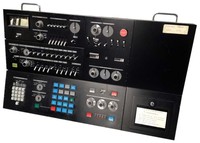IBM System 370 Control Panel
| Home > Browse Our Collection > Computers > IBM > IBM System 370 Control Panel |
|
The IBM System/370 (S/370) was a model range of IBM mainframes announced on June 30, 1970 as the successors to the System/360 family. The series maintained backward compatibility with the S/360, allowing an easy migration path for customers; this, plus improved performance, were the dominant themes of the product announcement. Improvements over the S/360 first released in the S/370 model range included: standard dual-processor capability; "monolithic main memory" based on integrated circuits instead of magnetic cores; full support for virtual memory through a new microcode floppy disk on the 370/145 and a hardware upgrade to include a DAT box on the 370/155 and 370/165; these were not announced until 1972; 128-bit floating point arithmetic on all models The original System/370 line underwent several architectural improvements during its roughly 20-year lifetime. One very significant change was the introduction of virtual memory , which was first made generally available in 1972 via IBM's "System/370 Advanced Function" announcement. IBM had initially (and controversially) chosen to exclude virtual storage from the S/370 line. The August 2nd, 1972 announcement included: Four new operating systems: DOS/VS (DOS with virtual storage), OS/VS1 (OS/360 MFT with virtual storage), OS/VS2 (OS/360 MVT with virtual storage) Release 1, termed SVS (Single Virtual Storage), and Release 2, termed MVS (Multiple Virtual Storage) and planned to be available 20 months later (at the end of March 1974), and VM/370 – the re-implemented CP/CMS The control panel from the IBM 370 system that was used at Cambridge University was kindly donated by the Cambridge University Computing Service. Manufacturer: IBM Comment on This Page IBM System 370 Control Panel Manuals:
Other Systems Related To IBM System 370 Control Panel:This exhibit has a reference ID of CH31058. Please quote this reference ID in any communication with the Centre for Computing History. |
Click on the Image(s) For Detail
|











